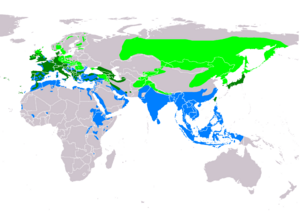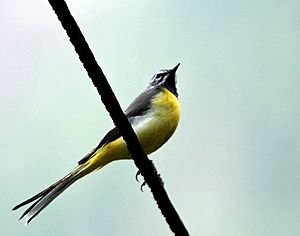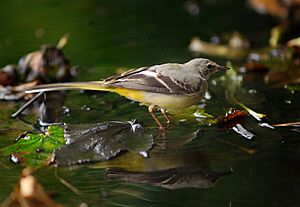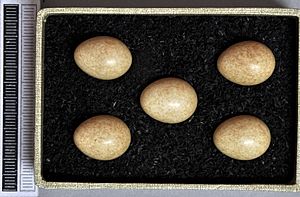Grey wagtail facts for kids
Quick facts for kids Grey wagtail |
|
|---|---|
 |
|
| Grey wagtail in Hyderabad, India | |
| Conservation status | |
| Scientific classification | |
 |
|
| Range of M. cinerea Extant, breeding Extant, resident Extant, non-breeding | |
| Synonyms | |
|
Motacilla melanope |
The grey wagtail (Motacilla cinerea) is a small, active bird from the wagtail family. It measures about 18–19 cm long. This bird looks a bit like the yellow wagtail. However, the grey wagtail only has yellow on its throat and under its tail.
Male grey wagtails have a black throat during breeding season. These birds live in many places. Some populations breed in Europe and Asia, then fly to warmer parts of Asia and Africa for winter. Grey wagtails love to be near moving water, like streams and rivers. They often build their nests near these watery places. Like other wagtails, they often wag their tails up and down. They fly low with a wavy motion and make a sharp call while flying.
Contents
About the Grey Wagtail's Name
The scientific name for the grey wagtail is Motacilla cinerea. This name was given by Marmaduke Tunstall in 1771. The word Motacilla is a Latin name for wagtails. It means "to move about," which fits how these birds constantly move their tails. The word cinerea is Latin for "ash-grey," describing the bird's color.
Scientists are still learning about how this species is related to other wagtails. The grey wagtail is part of a group of wagtails that do not live in Africa. These birds can look very similar, making it tricky to figure out their exact family tree.
There are three main types, or subspecies, of the grey wagtail:
- M. c. patriciae – Found in the Azores islands.
- M. c. schmitzi – Found in Madeira islands.
- M. c. cinerea – Found across western Europe, the Canary Islands, northwest Africa, and parts of Asia.
What Does a Grey Wagtail Look Like?
This wagtail is slender and has a thin white stripe above its eye. It also has a broken white ring around its eye. Its upper body is grey, and its bright yellow underside, especially near its tail, makes it easy to spot. During breeding season, the male has a black throat with white stripes on the sides of its mouth.
Grey wagtails usually look for food alone or in pairs. They search in grassy areas or shallow water. They often perch on rocks in the water or on trees. They have a clear, sharp call. Their song is made up of fast, trilling sounds.
Where Do Grey Wagtails Live?
These birds live in many parts of Europe and Asia. Different groups of grey wagtails live in different areas. The main type, M. c. cinerea, lives in western Europe, including places like the British Isles and Scandinavia. Another type, melanope, lives in eastern Europe and central Asia, often in mountain ranges. These birds fly to Africa and Asia for the winter.
The type called robusta breeds in northeastern Asia, including Siberia, Korea, and Japan. These birds spend their winters in Southeast Asia. There are also special island types, like patriciae in the Azores, schmitzi in Madeira, and canariensis in the Canary Islands. Sometimes, these birds even show up in Alaska or California, far from their usual homes.
Grey Wagtail Life and Habits
The breeding season for grey wagtails is from April to July. They build their nests near fast-flowing streams or rivers. Nests are often hidden among stones and roots on riverbanks. During courtship, the male flies up into the air and slowly floats down, making many quick, high-pitched chirping sounds. In Europe, they sometimes build nests in holes in human-made structures.
A female grey wagtail usually lays 3 to 6 speckled eggs. They might have more than one group of chicks in a season. In Ireland, they usually lay five eggs, and about 80% of their nests are successful. Predators eating eggs or chicks are the main reason for nests failing. On the Canary Islands, they lay fewer eggs, and their breeding season is longer.
The eggs hatch in about two weeks. The young birds are ready to fly about two weeks after hatching. Grey wagtails can live for up to 8 years in the wild.
These birds eat many kinds of water insects. This includes adult flies, mayflies, beetles, small crabs, and snails. In winter, they often look for food along roadsides. If startled, they make a sharp "chi-cheep" sound and fly a short distance away, often returning to the same spot.
In winter, grey wagtails sometimes gather in small groups to sleep. Birds that spend the winter in certain places often come back to the same spots each year, even small gardens in cities.
Sometimes, other birds like the common cuckoo lay their eggs in a grey wagtail's nest, making the wagtail raise the cuckoo chicks. Kestrels are also known to hunt grey wagtails.
See also
 In Spanish: Lavandera cascadeña para niños
In Spanish: Lavandera cascadeña para niños





